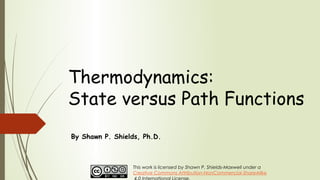Thermodynamics State vs Path Functions
•Download as PPT, PDF•
7 likes•15,012 views
This document discusses state functions and path functions in thermodynamics. It defines a state function as a property that depends only on the initial and final states of a system and not on the path between them. Examples given are changes in internal energy, enthalpy, pressure, temperature and volume. In contrast, a path function depends on the specific path or process taken between the initial and final states, with work and heat given as examples. The document provides an overview to distinguish state functions from path functions in thermodynamics.
Report
Share
Report
Share

Recommended
Recommended
Phase equilibria by Meenakshi 

Phase equilibria by Meenakshi Minal Saini , student of Chaudhary bansilal University , Bhiwani, Haryana
More Related Content
What's hot
Phase equilibria by Meenakshi 

Phase equilibria by Meenakshi Minal Saini , student of Chaudhary bansilal University , Bhiwani, Haryana
What's hot (20)
Chem 2 - Chemical Equilibrium IX: Le Chatelier's Principle and Pressure - Vol...

Chem 2 - Chemical Equilibrium IX: Le Chatelier's Principle and Pressure - Vol...
Partial gibbs free energy and gibbs duhem equation

Partial gibbs free energy and gibbs duhem equation
Viewers also liked
Viewers also liked (20)
Similar to Thermodynamics State vs Path Functions
Similar to Thermodynamics State vs Path Functions (20)
Thermodynamics part 1 ppt |Sumati's biochemistry |

Thermodynamics part 1 ppt |Sumati's biochemistry |
Unit 1 thermodynamics by varun pratap singh (2020-21 Session)

Unit 1 thermodynamics by varun pratap singh (2020-21 Session)
CHAPTER 1.1 - BASIC CONCEPTS OF THERMODYNAMICS.pdf

CHAPTER 1.1 - BASIC CONCEPTS OF THERMODYNAMICS.pdf
Basic Mechanical Engineering Unit 4 Thermodynamics@by V.P.Singh

Basic Mechanical Engineering Unit 4 Thermodynamics@by V.P.Singh
ME2036- ENGINEERING THERMODYNAMICS BY Mr.P.SATHISH

ME2036- ENGINEERING THERMODYNAMICS BY Mr.P.SATHISH
More from Lumen Learning
More from Lumen Learning (20)
The Second Law of Thermodynamics: Entropy and Heat IV

The Second Law of Thermodynamics: Entropy and Heat IV
Chem 2 - Third Law of Thermodynamics and Standard Molar Entropy V

Chem 2 - Third Law of Thermodynamics and Standard Molar Entropy V
Chem 2 - The Second Law of Thermodynamics: Spontaneous Reactions and Entropy S I

Chem 2 - The Second Law of Thermodynamics: Spontaneous Reactions and Entropy S I
Chem 2 - Gibbs Free Energy and Spontaneous Reactions VI

Chem 2 - Gibbs Free Energy and Spontaneous Reactions VI
Chem 2 - Free Energy and the Equilbrium Constant K VIII

Chem 2 - Free Energy and the Equilbrium Constant K VIII
Chem 2 - The Second Law of Thermodynamics: Entropy and Heat IV

Chem 2 - The Second Law of Thermodynamics: Entropy and Heat IV
Chem 2 - The Second Law of Thermodynamics: Predicting Entropy Changes Qualita...

Chem 2 - The Second Law of Thermodynamics: Predicting Entropy Changes Qualita...
Chem 2 - The Second Law of Termodynamics: Entropy Microstates and the Boltzma...

Chem 2 - The Second Law of Termodynamics: Entropy Microstates and the Boltzma...
Chem 2 - Acid-Base Equilibria VI: Weak Base Equilibria and Kb - Calculating p...

Chem 2 - Acid-Base Equilibria VI: Weak Base Equilibria and Kb - Calculating p...
Chem 2 - Acid-Base Equilibria V: Weak Acid Equilibria and Calculating the pH ...

Chem 2 - Acid-Base Equilibria V: Weak Acid Equilibria and Calculating the pH ...
Chem 2 - Acid-Base Equilibria IV: Calculating the pH of Strong Acids versus W...

Chem 2 - Acid-Base Equilibria IV: Calculating the pH of Strong Acids versus W...
Thermodynamics State vs Path Functions
- 1. Thermodynamics: State versus Path Functions By Shawn P. Shields, Ph.D. This work is licensed by Shawn P. Shields-Maxwell under a Creative Commons Attribution-NonCommercial-ShareAlike
- 2. Overview When we talk about a given system, we say it is in a particular “thermodynamic state.” A particular thermodynamic state is characterized by a few “macroscopic observables,” such as Pressure, temperature, volume, color, altitude, etc.
- 3. Differences (Changes) in Macroscopic Observables Changes in Pressure (P), Volume (V), and Temperature (T): What can we say about all of these? It doesn’t matter how the system arrived at the final state from the initial state, the difference (or change) is the same.
- 4. A Thermodynamic “State Function” State Functions only depend on the current (thermodynamic) state of the system. How the system attained that state does not matter! Example: Compression of a gas inside a piston. Vi Vf
- 5. A Thermodynamic “State Function” A State Function is defined as a property of a system that only depends on the initial and final state of the system, and is independent of the path followed in getting from one to the other.Ti Tf ∆T T Ti Tf ∆T T
- 6. Examples of State Functions ∆U is a state function. Some other state functions… ∆H (Enthalpy, coming soon…) ∆P ∆T ∆V Altitude Mass chemical composition
- 7. Path Functions A path function does depend on the path followed in getting from the initial to the final state. "Path near Clonmass Bay - geograph.org.uk - 899872" by Ross - From geograph.org.uk. Licensed under Creative Commons Attribution-Share Alike 2.0 via Wikimedia Commons - http://commons.wikimedia.org/wiki/File:Path_near_Clonmass_Bay_-_geograph.org.uk_- _899872.jpg#mediaviewer/File:Path_near_Clonmass_Bay_-_geograph.org.uk_-_899872.jpg
- 8. Path Functions Work (w) and heat (q) are path functions. Two rock climbers of equal mass scale the same cliff. One climbs straight up while the other backslides numerous times on the way up… who did more work? Cliffs along the Atlantic coastline of County Mayo, near Ballycastle, Ireland by Phil Armitage (public domain)
- 9. What You Should Be Able to Do (so far) Define a state function Recognize state functions from examples given. Define a path function. Recognize examples of path functions.
- 10. What You Should Be Able to Do (so far) Define a state function Recognize state functions from examples given. Define a path function. Recognize examples of path functions.
Editor's Notes
- <number>
- <number>
- <number>
- <number>
- <number>
- <number>
- <number>
- <number>
- <number>
